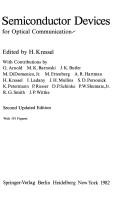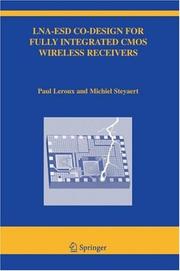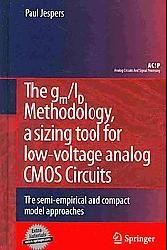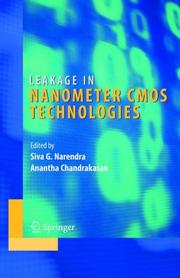| Listing 1 - 10 of 53 | << page >> |
Sort by
|
Book
ISSN: 18684513 ISBN: 9783642007101 9783642007095 3642007090 3642007104 Year: 2010 Publisher: Berlin, Heidelberg Springer Berlin Heidelberg
Abstract | Keywords | Export | Availability | Bookmark
 Loading...
Loading...Choose an application
- Reference Manager
- EndNote
- RefWorks (Direct export to RefWorks)
This fourth edition of the well-established Fundamentals of Semiconductors serves to fill the gap between a general solid-state physics textbook and research articles by providing detailed explanations of the electronic, vibrational, transport, and optical properties of semiconductors. The approach is physical and intuitive rather than formal and pedantic. Theories are presented to explain experimental results. This textbook has been written with both students and researchers in mind. Its emphasis is on understanding the physical properties of Si and similar tetrahedrally coordinated semiconductors. The explanations are based on physical insights. Each chapter is enriched by an extensive collection of tables of material parameters, figures, and problems. Many of these problems "lead the student by the hand" to arrive at the results. The major changes made in the fourth edition include: an extensive appendix about the important and by now well-established deep center known as the DX center, additional problems and the solutions to over fifty of the problems at the end of the various chapters. Some of the solutions contain extensions via discussion about topics of current interest in the field of semiconductor physics, such as spin-orbit coupling and k-linear band dispersion.

ISBN: 9780387096377 9780387096360 3540096361 9783540096368 0387096361 Year: 1980 Volume: 39 Publisher: Berlin ; New York : Springer-Verlag,
Abstract | Keywords | Export | Availability | Bookmark
 Loading...
Loading...Choose an application
- Reference Manager
- EndNote
- RefWorks (Direct export to RefWorks)
It has become increasingly evident in recent years that, apart from the key role that thrombin plays in the blood coagulation cascade, thrombin also elicits cellular actions via the activation of proteinase-activated receptors, which are present in many cell types. These effects of thrombin are seen in a variety of physiological as well as pathological phenomena, including vascular development and physiology, tumor progression and metastasis, neuronal functions, inflammation, angiogenesis. Thrombin: Physiology and Disease, edited by Michael E. Maragoudakis and Nikos E. Tsopanoglou, emphasizes the new developments in this important field of research and provides the basis for translating these findings into therapeutic targets."
Book
ISBN: 9783642138843 9783642138836 9783642138850 Year: 2010 Publisher: Berlin, Heidelberg Springer Berlin Heidelberg
Abstract | Keywords | Export | Availability | Bookmark
 Loading...
Loading...Choose an application
- Reference Manager
- EndNote
- RefWorks (Direct export to RefWorks)
The Physics of Semiconductors contains ample material for a comprehensive upper-level undergraduate or beginning graduate course, guiding readers to the point where they can choose a special topic and begin supervised research. The textbook provides a balance between essential aspects of solid-state and semiconductor physics, on the one hand, and the principles of various semiconductor devices and their applications in electronic and photonic devices, on the other. It highlights many practical aspects of semiconductors such as alloys, strain, heterostructures, nanostructures, that are necessary in modern semiconductor research but typically omitted in textbooks. Coverage also includes additional advanced topics, such as Bragg mirrors, resonators, polarized and magnetic semiconductors. The text derives explicit formulas for many results to support better understanding of the topics. The Physics of Semiconductors requires little or no prior knowledge of solid-state physics and evolved from a highly regarded two-semester course. In the second edition many topics are extended and treated in more depth. e.g. dopant diffusion, nanowires, recombination in organic semiconductors, multi-junction solar cells, quantum dot and organic LEDs, thin film transistors, carbon-based nanostructures and transparent conductive oxides.
Solid state physics --- Chemical structure --- Electronics --- Electrical engineering --- Biotechnology --- legeringen --- vaste stof --- materie (fysica) --- nanotechniek --- biotechnologie --- elektronica --- micro-elektronica --- halfgeleiders --- elektrische circuits --- Nanotechnology --- Semiconductors --- 621.315.5 --- 621.315.5 Conductors and semiconductors according to material --- Conductors and semiconductors according to material --- Crystalline semiconductors --- Semi-conductors --- Semiconducting materials --- Semiconductor devices --- Crystals --- Solid state electronics --- Molecular technology --- Nanoscale technology --- High technology --- Electronic materials --- Materials

ISBN: 1280283521 9786610283521 1402031912 1402031904 1441952675 9781402031915 9780387522777 Year: 2005 Publisher: Boston, MA Springer
Abstract | Keywords | Export | Availability | Bookmark
 Loading...
Loading...Choose an application
- Reference Manager
- EndNote
- RefWorks (Direct export to RefWorks)
LNA-ESD Co-Design for Fully Integrated CMOS Wireless Receivers fits in the quest for complete CMOS integration of wireless receiver front-ends. With a combined discussion of both RF and ESD performance, it tackles one of the final obstacles on the road to CMOS integration. The book is conceived as a design guide for those actively involved in the design of CMOS wireless receivers. The book starts with a comprehensive introduction to the performance requirements of low-noise amplifiers in wireless receivers. Several popular topologies are explained and compared with respect to future technology and frequency scaling. The ESD requirements are introduced and related to the state-of-the-art protection devices and circuits. LNA-ESD Co-Design for Fully Integrated CMOS Wireless Receivers provides an extensive theoretical treatment of the performance of CMOS low-noise amplifiers in the presence of ESD-protection circuitry. The influence of the ESD-protection parasitics on noise figure, gain, linearity, and matching are investigated. Several RF-ESD co-design solutions are discussed allowing both high RF-performance and good ESD-immunity for frequencies up to and beyond 5 GHz. Special attention is also paid to the layout of both active and passive components. LNA-ESD Co-Design for Fully Integrated CMOS Wireless Receivers offers the reader intuitive insight in the LNA’s behavior, as well as the necessary mathematical background to optimize its performance. All material is experimentally verified with several CMOS implementations, among which a fully integrated GPS receiver front-end. The book is essential reading for RF design engineers and researchers in the field and is also suitable as a text book for an advanced course on the subject.
Amplifiers (Electronics) --- Metal oxide semiconductors, Complementary. --- Digital communications. --- Communications, Digital --- Digital transmission --- Pulse communication --- Digital electronics --- Pulse techniques (Electronics) --- Telecommunication --- Digital media --- Signal processing --- CMOS (Electronics) --- Complementary metal oxide semiconductors --- Semiconductors, Complementary metal oxide --- Logic circuits --- Transistor-transistor logic circuits --- Amps (Electronics) --- Electronic amplifiers --- Radio amplifiers --- Electronics --- Design and construction. --- Digital techniques --- Digital communications --- Metal oxide semiconductors, Complementary --- Design and construction --- Computer engineering. --- Engineering design. --- Electronics. --- Electrical Engineering. --- Engineering Design. --- Electronics and Microelectronics, Instrumentation. --- Electrical engineering --- Physical sciences --- Design, Engineering --- Engineering --- Industrial design --- Strains and stresses --- Computers --- Design --- 621.382 --- CMOS --- Computer engineering --- GPS --- Halfgeleiders --- Telecommunicatie --- Digitale communicatie --- Electrical engineering. --- Microelectronics. --- Microminiature electronic equipment --- Microminiaturization (Electronics) --- Microtechnology --- Semiconductors --- Miniature electronic equipment --- Electric engineering
Book
ISBN: 9781402085734 1402085729 9781402085727 9048179157 1402085737 Year: 2008 Publisher: [Dordrecht] : Springer,
Abstract | Keywords | Export | Availability | Bookmark
 Loading...
Loading...Choose an application
- Reference Manager
- EndNote
- RefWorks (Direct export to RefWorks)
Structured Analog CMOS Design describes a structured analog design approach that makes it possible to simplify complex analog design problems and develop a design strategy that can be used for the design of large number of analog cells. It intentionally avoids treating the analog design as a mathematical problem, developing a design procedure based on the understanding of device physics and approximations that give insight into parameter interdependences. The proposed transistor-level design procedure is based on the EKV modeling approach and relies on the device inversion level as a fundamental design variable. Since all important design parameters can be expressed as continuous functions of the device inversion level, the design optimum as well as the technology limits can be easily found. The basic design concept consists in analog cell partitioning into the basic analog structures and sizing of these basic analog structures in a predefined procedural design sequence. The procedural design sequence ensures the correct propagation of design specifications, the verification of parameter limits and the local optimization loops. The proposed design procedure is also implemented as a CAD tool that follows this book. Finally, as a practical example, the design of analog amplifiers in a hybrid multi-bit Delta-Sigma modulator system is described in detail from system level to transistor level.
Engineering. --- Circuits and Systems. --- Processor Architectures. --- Computer science. --- Systems engineering. --- Ingénierie --- Informatique --- Ingénierie des systèmes --- Dielectrics. --- Electronic analog computers -- Circuits. --- Metal oxide semiconductors, Complementary. --- Metal oxide semiconductors. --- Electrical & Computer Engineering --- Engineering & Applied Sciences --- Electrical Engineering --- Electronic analog computers --- Circuits. --- Analog computer circuits --- CMOS (Electronics) --- Complementary metal oxide semiconductors --- Semiconductors, Complementary metal oxide --- Microprocessors. --- Electronics. --- Microelectronics. --- Electronic circuits. --- Electronics and Microelectronics, Instrumentation. --- Electronic circuits --- Digital electronics --- Logic circuits --- Transistor-transistor logic circuits --- Informatics --- Science --- Engineering systems --- System engineering --- Engineering --- Industrial engineering --- System analysis --- Electrical engineering --- Physical sciences --- Design and construction --- Minicomputers --- Electron-tube circuits --- Electric circuits --- Electron tubes --- Electronics --- Microminiature electronic equipment --- Microminiaturization (Electronics) --- Microtechnology --- Semiconductors --- Miniature electronic equipment
Book
ISBN: 9783642054105 9783642054112 Year: 2010 Publisher: Berlin, Heidelberg Springer Berlin Heidelberg
Abstract | Keywords | Export | Availability | Bookmark
 Loading...
Loading...Choose an application
- Reference Manager
- EndNote
- RefWorks (Direct export to RefWorks)
Stochastic Energetics by now commonly designates the emerging field that bridges the gap between stochastic dynamical processes and thermodynamics. Triggered by the vast improvements in spatio-temporal resolution in nanotechnology, stochastic energetics develops a framework for quantifying individual realizations of a stochastic process on the mesoscopic scale of thermal fluctuations. This is needed to answer such novel questions as: Can one cool a drop of water by agitating an immersed nano-particle? How does heat flow if a Brownian particle pulls a polymer chain? Can one measure the free-energy of a system through a single realization of the associated stochastic process? This book will take the reader gradually from the basics to the applications: Part I provides the necessary background from stochastic dynamics (Langevin, master equation), Part II introduces how stochastic energetics describes such basic notions as heat and work on the mesoscopic scale, Part III details several applications, such as control and detection processes, as well as free-energy transducers. It aims in particular at researchers and graduate students working in the fields of nanoscience and technology.
Statistical physics --- Physics. --- Semiconductors. --- Single Molecule Studies, Molecular Motors. --- Statistical Physics, Dynamical Systems and Complexity. --- Thermodynamics. --- Theoretical and Computational Chemistry. --- Chemistry. --- Physique --- Chimie --- Thermodynamique
Book
ISBN: 128118019X 9786611180195 1402067909 1402067895 9048177286 9781402067891 9781402067907 Year: 2008 Publisher: Dordrecht Springer Science + Business Media B.V
Abstract | Keywords | Export | Availability | Bookmark
 Loading...
Loading...Choose an application
- Reference Manager
- EndNote
- RefWorks (Direct export to RefWorks)
Design of high voltage xDSL line drivers in standard CMOS fits in the quest for highly efficient fully integrated xDSL modems for central office applications. The book focusses on the line driver, the most demanding building block of the xDSL modem for lowering power. To reduce the cost, the cheapest technology is selected: standard CMOS, without any extra process options to increase the nominal supply voltage. The emphasis lies on the analysis, design and implementation of high voltage highly efficient line drivers in mainstream CMOS. Design of high voltage xDSL line drivers in standard CMOS starts from the Self-Oscillating Power Amplifier (SOPA), a highly efficient line driver for xDSL applications. However, in the nano-electronic era, the low supply voltage of CMOS results in very low efficiencies for line drivers and power amplifiers in general. In this book a technique is developed for designing high voltage circuits in a low voltage mainstream CMOS technology. Several practical design examples reveal the subtleties and challenges encountered during the design of high voltage circuits in low voltage standard CMOS. Such a high voltage buffer is then integrated into the SOPA architecture leading to the implementation of a high voltage highly efficient aDSL2+ line driver in a 1.2V 130nm mainstream CMOS technology. Design of high voltage xDSL line drivers in standard CMOS covers the total design flow of monolithic CMOS high voltage circuits. The book is essential reading for analog design engineers and researchers in the field and is also suitable as a text book for an advanced course on the subject.
Line drivers (Integrated circuits) --- Metal oxide semiconductors, Complementary. --- Design and construction. --- CMOS (Electronics) --- Complementary metal oxide semiconductors --- Semiconductors, Complementary metal oxide --- Digital electronics --- Logic circuits --- Transistor-transistor logic circuits --- Buffers, Tri-state (Integrated circuits) --- Drivers, Line (Integrated circuits) --- Tri-state buffers (Integrated circuits) --- Amplifiers (Electronics) --- Computer interfaces --- Integrated circuits --- Systems engineering. --- Electronics. --- Computer engineering. --- Telecommunication. --- Circuits and Systems. --- Electronics and Microelectronics, Instrumentation. --- Electrical Engineering. --- Communications Engineering, Networks. --- Electric communication --- Mass communication --- Telecom --- Telecommunication industry --- Telecommunications --- Communication --- Information theory --- Telecommuting --- Computers --- Electrical engineering --- Physical sciences --- Engineering systems --- System engineering --- Engineering --- Industrial engineering --- System analysis --- Design and construction --- Electronic circuits. --- Microelectronics. --- Electrical engineering. --- Electric engineering --- Microminiature electronic equipment --- Microminiaturization (Electronics) --- Electronics --- Microtechnology --- Semiconductors --- Miniature electronic equipment --- Electron-tube circuits --- Electric circuits --- Electron tubes --- Metal oxide semiconductors, Complementary
Book
ISBN: 9780387473147 0387473130 9780387473130 9786612824128 1282824120 0387473149 Year: 2008 Publisher: New York : Springer,
Abstract | Keywords | Export | Availability | Bookmark
 Loading...
Loading...Choose an application
- Reference Manager
- EndNote
- RefWorks (Direct export to RefWorks)
Fundamentals of Power Semiconductor Devices provides an in-depth treatment of the physics of operation of power semiconductor devices that are commonly used by the power electronics industry. Analytical models for explaining the operation of all power semiconductor devices are developed. The treatment focuses on silicon devices but includes the unique attributes and design requirements for emerging silicon carbide devices. Drawing upon years of practical experience and using numerous examples and illustrative applications, B. Jayant Baliga discusses: Numerical simulation examples to elucidate the operating physics and validate the models Device performance attributes that allow practicing engineers in the industry to develop products Treatment of all types of power rectifiers and transistors to create a comprehensive reference in the field Fundamentals of Power Semiconductor Devices will be of interest to practicing engineers in the power semiconductor device community and can also serve as an ideal textbook for teaching courses on power semiconductor devices due to the extensive analytical treatment provided for all device structures.
Engineering. --- Energy Technology. --- Circuits and Systems. --- Electronics and Microelectronics, Instrumentation. --- Solid State Physics. --- Spectroscopy and Microscopy. --- Energy, general. --- Electronics. --- Systems engineering. --- Electric engineering. --- Ingénierie --- Electronique --- Ingénierie des systèmes --- Engineering, Electrical. --- Power semiconductors. --- Electrical & Computer Engineering --- Engineering & Applied Sciences --- Electrical Engineering --- Semiconductors. --- Crystalline semiconductors --- Semi-conductors --- Semiconducting materials --- Semiconductor devices --- Energy. --- Solid state physics. --- Electric power production. --- Spectroscopy. --- Microscopy. --- Microelectronics. --- Electronic circuits. --- Crystals --- Electrical engineering --- Electronics --- Solid state electronics --- Power electronics --- Semiconductors --- Materials --- Energy Systems. --- Engineering systems --- System engineering --- Engineering --- Industrial engineering --- System analysis --- Physical sciences --- Design and construction --- Energy systems. --- Electron-tube circuits --- Electric circuits --- Electron tubes --- Microminiature electronic equipment --- Microminiaturization (Electronics) --- Microtechnology --- Miniature electronic equipment --- Analysis, Microscopic --- Light microscopy --- Micrographic analysis --- Microscope and microscopy --- Microscopic analysis --- Optical microscopy --- Optics --- Analysis, Spectrum --- Spectra --- Spectrochemical analysis --- Spectrochemistry --- Spectrometry --- Spectroscopy --- Chemistry, Analytic --- Interferometry --- Radiation --- Wave-motion, Theory of --- Absorption spectra --- Light --- Spectroscope --- Physics --- Solids --- Qualitative --- Analytical chemistry

ISBN: 9780387471013 9780387471006 0387471006 1461425050 9786612838095 1282838091 0387471014 Year: 2010 Publisher: Dordrecht : Springer,
Abstract | Keywords | Export | Availability | Bookmark
 Loading...
Loading...Choose an application
- Reference Manager
- EndNote
- RefWorks (Direct export to RefWorks)
How to determine transistor sizes and currents when the supply voltages of analog CMOS circuits do not exceed 1.2V and transistors operate in weak, moderate or strong inversion? The gm/ID methodology offers a solution provided a reference transconductance over drain current ratio is available. The reference may be the result of measurements carried out on real physical transistors or advanced models. The reference may also take advantage of a compact model. In The gm/ID Methodology, a Sizing Tool for Low-Voltage Analog CMOS Circuits, we compare the semi-empirical to the compact model approach. Small numbers of parameters make the compact model attractive for the model paves the way towards analytic expressions unaffordable otherwise. The E.K.V model is a good candidate, but when it comes to short channel devices, compact models are either inaccurate or loose straightforwardness. Because sizing requires basically a reliable large signal representation of MOS transistors, we investigate the potential of the E.K.V model when its parameters are supposed to be bias dependent. The model-driven and semi-empirical methods are compared considering the Intrinsic Gain Stage and a few more complex circuits. A series of MATLAB files found on extras-springer.com allow redoing the tests.
Engineering. --- Circuits and Systems. --- Processor Architectures. --- Solid State Physics. --- Spectroscopy and Microscopy. --- Computer science. --- Systems engineering. --- Ingénierie --- Informatique --- Ingénierie des systèmes --- Metal oxide semiconductors, Complementary --- Low voltage integrated circuits --- Linear integrated circuits --- Design and construction --- Design and construction. --- Linear integrated circuits -- Design and construction. --- Low voltage integrated circuits -- Design and construction. --- Metal oxide semiconductors, Complementary -- Design and construction. --- Electrical Engineering --- Electrical & Computer Engineering --- Engineering & Applied Sciences --- MOS complémentaires --- Circuits intégrés à faible consommation --- Circuits intégrés linéaires --- Conception et construction --- Microprocessors. --- Solid state physics. --- Spectroscopy. --- Microscopy. --- Electronics. --- Microelectronics. --- Electronic circuits. --- Electronics and Microelectronics, Instrumentation. --- Conception et construction. --- Metal oxide semiconductors, Complementary - Design and construction --- Low voltage integrated circuits - Design and construction --- Linear integrated circuits - Design and construction --- MOS complémentaires --- Circuits intégrés à faible consommation --- Circuits intégrés linéaires

ISBN: 128061658X 9786610616589 0387281339 0387257373 9780387257372 9780387281339 Year: 2006 Publisher: Boston, MA Springer Science+Business Media, Inc.
Abstract | Keywords | Export | Availability | Bookmark
 Loading...
Loading...Choose an application
- Reference Manager
- EndNote
- RefWorks (Direct export to RefWorks)
Scaling transistors into the nanometer regime has resulted in a dramatic increase in MOS leakage (i.e., off-state) current. Threshold voltages of transistors have scaled to maintain performance at reduced power supply voltages. Leakage current has become a major portion of the total power consumption, and in many scaled technologies leakage contributes 30-50% of the overall power consumption under nominal operating conditions. Leakage is important in a variety of different contexts. For example, in desktop applications, active leakage power (i.e., leakage power when the processor is computing) is becoming significant compared to switching power. In battery operated systems, standby leakage (i.e., leakage when the processor clock is turned off) dominates as energy is drawn over long idle periods. Increased transistor leakages not only impact the overall power consumed by a CMOS system, but also reduce the margins available for design due to the strong relationship between process variation and leakage power. It is essential for circuit and system designers to understand the components of leakage, sensitivity of leakage to different design parameters, and leakage mitigation techniques in nanometer technologies. This book provides an in-depth treatment of these issues for researchers and product designers.
Metal oxide semiconductors, Complementary --- Integrated circuits --- Electric leakage --- Design and construction. --- Prevention. --- Electric action of points --- MOS complémentaires --- Circuits intégrés --- Fuite électrique --- Design and construction --- Prevention --- Conception et construction --- Prévention --- EPUB-LIV-FT SPRINGER-B LIVINGEN
| Listing 1 - 10 of 53 | << page >> |
Sort by
|

 Search
Search Feedback
Feedback About UniCat
About UniCat  Help
Help News
News